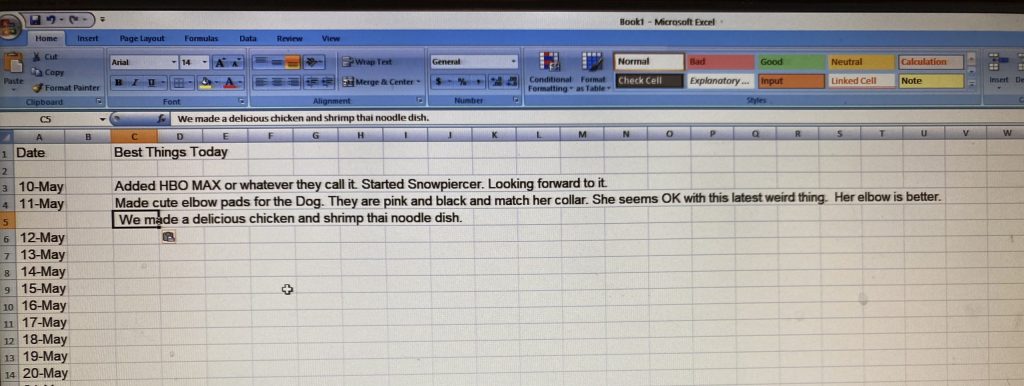Welcome to life on Planet X. We’ve had a long, lonely interlude since March of 2020. Maybe you never wanted to be an astronaut, reader, but somehow we all got shoved into the pod and shot into space. This new “normal” of masks and social distance still feels alien to many of us as we stand on the little red dots in various lines to get into places that no longer resemble their earlier selves. Getting my real ID license a few weeks back was an adventure in dissonance. No chairs except for a few for people waiting for their road test. Two people guarding the door and shepherding traffic. No lines. And, astoundingly, once I got past the gatekeepers, the whole thing took about 15 minutes.
Some things remain the same. They still wait for the worst moment to take that pic and then anything goes if your eyes happen to be open. Still, I’ve looked blanker and more confused, and my eyes (and unfortunately mouth) are somewhat open.
It’s been especially wild for teachers out here in space. These struggling professionals have kept going in and out of live learning while struggling with remote platforms and more remote students. They are working to the point of exhaustion sometimes, with varying amounts of success to show. The biggest problem with remote learning is a simple one: A kid can wander away, mentally or physically, and you don’t necessarily know the kid has left the ship.

Where is Zeke? Is he hiding in the galley, maybe eating Flamin’ Hot Cheetos? Has he gone to play his Xbox somewhere? Is there any chance mom might be able to get him back to work? Where is his mom? Something about being shot into space makes kids squirrelly (duh) and many “A” students would walk out of their classrooms if they could make their escape with reasonable odds of going unnoticed.
Eduhonesty: Gratitude journals help us keep our spirits up. So can guided meditations. Here’s my tip for this: Start small. You don’t need to plunge right into transcendental meditation. Almost nobody I know has time to commit hours to another self-improvement project. Finding my shoes and car keys can be enough progress on some mornings :-).
But YouTube abounds with short meditations. Fitbit has a meditation section. You can easily find source material. Want an app? 15 Best Meditation and Mindfulness Apps for 2021 (developgoodhabits.com) has a selection. Put meditation into Spotify or your music source.
Five minutes here, ten minutes there, another five minutes before dinner and you may find your stress levels have taken a dive. Some meditations are even designed to ease you into sleep. Some that are not designed for that purpose work well anyway; I love the Body Scan meditation by Jon Kabat-Zinn because I am almost always asleep before we get much past my left leg. Every time, he tells me to stay awake, but my stay-awake success rate is probably less than 1%. Need to sleep? This meditation has been helping me for years.
Kabat-Zinn’s mountain and lake meditations bring me to a better, calmer state of mind. YouTube is a motherlode of possible sources of stress reduction and relaxation. Here’s a sample sitting meditation: Mountain Meditation Exercise, Jon Kabat Zinn – Bing video. Sitting helps greatly when you must stay awake.
Pacing is highly individual in guided meditations. Some are too fast for me. They make me effort to follow, which works against calming. Certain voices also work better for me than others. If at first your attempts at guided meditation don’t work, don’t give up.
Many five to ten minute meditations can be found in cyberspace, mostly focused on breathing. Stress is all about breathing, as breath prepares us to fight or take flight. Breath reflects our state of mind, but it also creates that state. Anxiety feeds anxious breathing which feeds anxiety. Meditation can break that cycle.
Those whose school years are almost over may read this post and say, “Why now?” The answer lies in COVID-crazy school years. The district where I live will be finishing at the start of June. I talked to a friend this morning, however, who still has FIVE WEEKS left. We are making up for lost time all over this country and teachers who customarily are nearing the end of the end game at this point are sometimes now looking at an end in July, Stress is running high in hard-hit geographic pockets, especially for teachers and others who are going to be working outside of the house when their children are released for summer vacation.
Is that you, reader? Depending on the age of your children, a 30 minute meditation may sound like about as feasible as a backyard Mars launch. Sometimes half-hour chunks simply don’t exist. But 5 to 10 minute chunks can usually be carved out, even if you have to bribe the kids to do it. All that stuff about finding a quiet, uninterrupted time and turning off the phone during meditation? Definitely optional! Occasional quick shifts to Plan B come with the territory where children are concerned.
Reader, especially if your mood and energy are sinking, PRIORITIZE YOU. Throw in five meditation minutes when you feel the stress starting to climb. If you wake up first, seize those early moments before the household awakens. If you are fighting to get to sleep, look up meditations for that purpose. And promise yourself at least five minutes before you go to sleep.
Here’s a short meditation by Deepak Chopra to start or get you back into the meditation habit: Deepak Chopra’s Go-To 3-Minute Meditation To Stay Focused – YouTube
Hugs to my readers. The light in the distance really is the end of the tunnel, and not another freight train. Jocelyn Turner
P.S. If meditation always puts you to sleep, you are not getting enough sleep.





